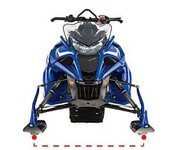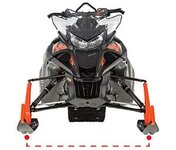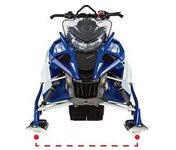GENESIS 998 TURBO ENGINE
We listened, we designed and then we tested. The new Genesis 998 Turbo engine is a product of our dedication to bringing the most advanced, high performance engines to the snowmobile industry. With more horsepower than any production engine in the history of our performance-obsessed sport, we are confident when we say the Sidewinder has the Power to Satisfy. Combine that with Yamaha’s fanatical dedication to durability and reliability, and we are doubly confident when we tell you that the Sidewinder will deliver Round-Trip Reliability.
Everything about the Sidewinder’s engine is pure Yamaha engineering—from the intake, to the large-finned intercooler to the spec of the high tech IHI ceramic bearing turbo unit to the high tech engine management system to the exhaust. Our master engine engineers engineered this engine from a blank sheet to give you the performance you would expect from a Yamaha turbo sled. The side-mounted turbo unit allows short pressure tubes for razor-sharp response. Our triple throttle bodies are a first in production turbo engines, regardless of industry. Not even the exotic car manufacturers go to this length to deliver crisp, right-now performance!
We have staked our reputation on quality, durability and reliability—more commonly referred to as Yamaha Quality. The 998 Turbo engine package carries a full suite of features to ensure you have a great day on the snow and a fun night when you reach your destination. We use our advanced nine-sensor engine management system to control fuel flow for maximum performance, but it also incorporates a knock sensor to adjust ignition timing and even manifold pressure if the need should arise. We developed the crank and rods to handle the amazingly high torque load of the 998 Turbo. We even redesigned the oil tank for optimal oil flow when the Sidewinder’s nose is elevated.
Yamaha has well over a decade of experience in harnessing the unique power delivery of a high performance four stroke engine. For the hyper performance Sidewinder, we have developed a new YSRC roller secondary system to deliver aggressive upshifting while also backshifting quickly to keep you in the power. In addition, we slightly upsized the new secondary to overshift and let the Sidewinder stretch its legs on a long lake run.
From intake to exhaust, and through the driveline, the new Sidewinder is engineered by Yamaha to deliver the Power to Satisfy, with Roundtrip Reliability!
High Tech Turbo
The Nickel alloy turbine body is extremely strong and precise, able to withstand highly elevated temperatures. Supported by premium, ceramic ball bearings, the Inconel turbine blade assembly is very light and strong. This yields a low moment of inertia for lightening quick response to exhaust gas input.
]Connecting Rod
Special, light weight, hardened carburized steel connecting rod design has the optimum strength required to produce maximum power. This new turbo-specific rod design uses nutted studs to join the close-tolerance, machined-faced big end. The rods are also treated with a special Defric coating for cold start protection, to ensure long life and maximum reliability.
Mitsubishi® ECU
The Yamaha-developed Mitsubishi® ECU uses a series of 9 sensors to gather running condition data and computes using its predetermined memory ‘map’. It then adjusts ignition timing, fuel delivery, manifold air-pressure and turbo boost pressure to produce maximum performance - reliably.
Forged Pistons
The forged aluminum pistons are formed without melting the original aluminum stock, so they retain the strength of the original solidification structure, which enables the design of a lighter piston. The forging process also allows Yamaha to control material thickness to reduce weight by eliminating unnecessary material while still maintaining high strength. A form optimized scraper ring provides maximum protection against oil consumption and blow-by.
Piston Cooler
The Genesis Turbo engine features a unique piston cooling system. Oil is sprayed directly at the underside of the pistons through special jets to help cool and lubricate them. Cooling the pistons helps ensure maximum reliability from this premium, ultimate performance Yamaha engine.
Triple Throttle Bodies
Yamaha engineers wanted to develop a turbo so smooth and so quick to respond that it doesn’t feel like a conventional turbo. One of the ways they achieved their goal was to develop the intake system using three separate throttle bodies instead of just one— something that is not seen in any other production turbo on the planet. And another first for Yamaha with the Genesis turbo.
]Exhaust Manifold
Yamaha engineers designed a unique cast steel 3 into 1 manifold to precisely match the chassis and turbo mounting layout to help create the shortest path possible to the turbine. This compact component is connected to the turbine by a short, vibration-isolating tube. This results in exhaust energy being transferred very efficiently to the turbine for instant response to the slightest throttle input.
Wow!!!! New ECU,new oil tank, new bigger roller secundery,stronger rods,crank,pistions,Piston Cooler a unique piston cooling system. Oil is sprayed directly at the underside of the pistons through special jets to help cool and lubricate them. +++++
This is aweysome





















